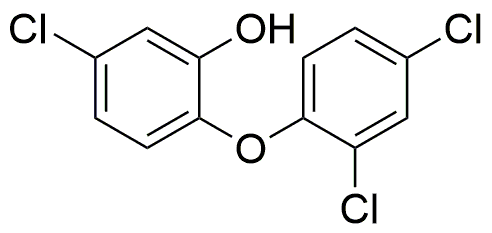Triclosan is widely utilized in research focused on:
- Antimicrobial Products: Commonly found in soaps, toothpaste, and personal care items, it helps reduce bacterial contamination, making it essential for hygiene products.
- Medical Applications: Used in some surgical scrubs and wound dressings, it provides antimicrobial protection, which is crucial in preventing infections in healthcare settings.
- Textiles: Incorporated into fabrics, it offers long-lasting antibacterial properties, making it beneficial for sportswear and hospital linens to reduce odor and bacterial growth.
- Household Cleaners: Found in various cleaning products, it enhances their effectiveness against germs, ensuring a safer environment in homes and workplaces.
- Research Studies: Frequently used in environmental studies to assess the impact of antimicrobial agents on ecosystems, helping researchers understand its effects on aquatic life and microbial communities.
General Information
Properties
Safety and Regulations
Applications
Triclosan is widely utilized in research focused on:
- Antimicrobial Products: Commonly found in soaps, toothpaste, and personal care items, it helps reduce bacterial contamination, making it essential for hygiene products.
- Medical Applications: Used in some surgical scrubs and wound dressings, it provides antimicrobial protection, which is crucial in preventing infections in healthcare settings.
- Textiles: Incorporated into fabrics, it offers long-lasting antibacterial properties, making it beneficial for sportswear and hospital linens to reduce odor and bacterial growth.
- Household Cleaners: Found in various cleaning products, it enhances their effectiveness against germs, ensuring a safer environment in homes and workplaces.
- Research Studies: Frequently used in environmental studies to assess the impact of antimicrobial agents on ecosystems, helping researchers understand its effects on aquatic life and microbial communities.
Documents
Safety Data Sheets (SDS)
The SDS provides comprehensive safety information on handling, storage, and disposal of the product.
Product Specification (PS)
The PS provides a comprehensive breakdown of the product’s properties, including chemical composition, physical state, purity, and storage requirements. It also details acceptable quality ranges and the product's intended applications.
Certificates of Analysis (COA)
Search for Certificates of Analysis (COA) by entering the products Lot Number. Lot and Batch Numbers can be found on a product’s label following the words ‘Lot’ or ‘Batch’.
*Catalog Number
*Lot Number
Certificates Of Origin (COO)
This COO confirms the country where the product was manufactured, and also details the materials and components used in it and whether it is derived from natural, synthetic, or other specific sources. This certificate may be required for customs, trade, and regulatory compliance.
*Catalog Number
*Lot Number
Safety Data Sheets (SDS)
The SDS provides comprehensive safety information on handling, storage, and disposal of the product.
DownloadProduct Specification (PS)
The PS provides a comprehensive breakdown of the product’s properties, including chemical composition, physical state, purity, and storage requirements. It also details acceptable quality ranges and the product's intended applications.
DownloadCertificates of Analysis (COA)
Search for Certificates of Analysis (COA) by entering the products Lot Number. Lot and Batch Numbers can be found on a product’s label following the words ‘Lot’ or ‘Batch’.
*Catalog Number
*Lot Number
Certificates Of Origin (COO)
This COO confirms the country where the product was manufactured, and also details the materials and components used in it and whether it is derived from natural, synthetic, or other specific sources. This certificate may be required for customs, trade, and regulatory compliance.


